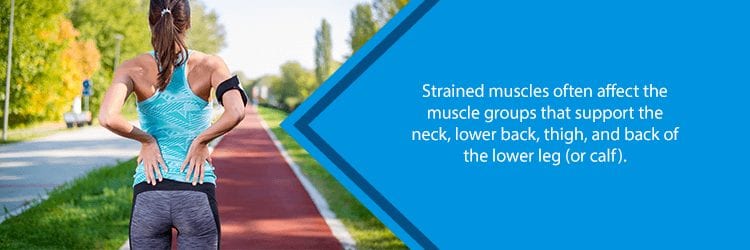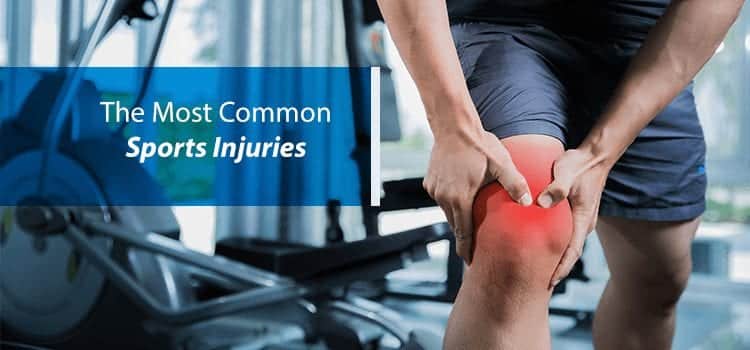Some people love the thrill of competition and the challenge of pushing their physical limits. If you are one of these people, then you’ve probably had a day or two when you pushed it too far. Maybe you felt soreness the next morning. Or, perhaps you’ve already spent some time in a doctor’s office.
Although you can’t avoid every setback, understanding common sports injuries will make you more aware of your body’s limitations.
Play hard. Don’t give up. But, be mindful of the ways you can get injured.
Muscle Strain or Sprain
Some of the most common sports injuries involve a muscle sprain or strain. Though these conditions share similar symptoms, the terms are not interchangeable. A strain involves a torn or damaged tendon, the soft tissue that connects muscle to bone. In contrast, a sprain is caused by overstretched or damaged ligaments that connect bones at the joints. Both types of injuries are common during physical activities like running, lifting, falling, or sudden jarring movements.
When suffering a sprain or strain, symptoms may include: pain, swelling, and limited movement. Strained muscles usually involve the back, neck, thigh, or the back of the lower leg. Sprains typically occur in the ankle, knee, wrists, hands, or fingers.
In many cases, strains and sprains heal with rest and ice. Anti-inflammatory medicines can also help. You may want to see a doctor if you’re experiencing significant pain, numbness, or can’t move the affected joint.

Tennis or Golfer’s Elbow
Don’t let the names fool you: just about anyone can acquire these unwanted elbow conditions. They result from overuse or repetitive movements that cause a tendon in the elbow to become damaged and inflamed. These injuries are common for those who participate in throwing activities, racquet sports, weight lifting, and other gripping activities.
Those who have tennis elbow feel pain on the outside of the elbow. In contrast, pain from golfer’s elbow is felt on the inside of the elbow. Symptoms include discomfort when gripping or lifting an object, tenderness in the elbow, and pain that radiates to the wrist or fingertips.
Conservative measures like rest, anti-inflammatory medications, and even massage will help with these symptoms.
Groin Pull
The groin is the area between the abdomen and thigh. A groin pull injury involves the adductor muscles of the thigh, which allow you to open and close your legs. This injury occurs while kicking, turning quickly, running, or jumping.
Symptoms of a groin pull include pain in the inner thigh, swelling, bruising, difficulty walking or running, and decreased upper leg strength. In most cases, this injury isn’t serious and can be treated with conservative measures to reduce pain and swelling.
Shin Splints
Shin splints occur when there is inflammation to the tendons, muscles, and bone tissue around the tibia (shinbone). The inflammation develops after a drastic change in an exercise routine or when the leg becomes overworked by repetitive activity.
Runners typically develop shin splints. Any athlete who plays a sport that requires running or repetitive leg movements, however, can develop this condition.
Rest, ice, and proper stretching helps to relieve the pain. Sometimes anti-inflammatory medicines like aspirin or ibuprofen are helpful. Orthotics and supportive footwear can help stabilize the foot and ankle and reduce stress on the shins. A doctor or sports medicine professional can give insights on how to prevent shin splints from reoccurring.

Sciatica
The sciatic nerve starts in your lower back and travels through your hips, buttocks, and down each leg. When this nerve is compressed by a bone spur, herniated disc, or narrowing of the spine, you can feel pain radiating from your lower spine all the way down the back of your leg. Other symptoms include tingling, numbness, or muscle weakness.
This condition is commonly seen in athletes who twist their backs often, such as tennis or golf players. Contact sports like football and wrestling where athletes suffer repeated hits to the back can also cause sciatica.
For many, sciatica is treated conservatively with rest, ice, and proper stretching. More severe cases may require pain medications, physical therapy, or surgery to address symptoms.
Torn ACL
The anterior cruciate ligament (ACL) is one of four main ligaments that provide stability to your knee. An ACL injury occurs when this ligament is torn, usually by a sudden movement during pivoting, landing, or cutting. It is also common in contact sports when someone hits the outside of a person’s planted leg.
One usually hears or feels a telltale “pop” when this knee injury occurs. Next comes the swelling and pain. In many cases, surgery is the best option for repairing the anterior cruciate ligament.
Patellofemoral Syndrome
Another common knee injury, patellofemoral syndrome involves pain in the front of the knee or kneecap (patella). The interaction of your patella and femur (thighbone), as well as the surrounding soft tissues, contribute to this condition. Symptoms include aching pain in the front of the knee when walking, using stairs, sitting for a long time, or squatting. Some experience popping or crackling sounds in the knee while moving.
Sometimes referred to as “runner’s knee” this injury is common for those who put repeated stress on their knees. Also, drastic changes in exercise habits, bad training techniques, and muscle weaknesses or imbalances play a factor.
While conservative treatments like resting and icing the area may help, if pain persists, then you may wish to see a doctor. Proper diagnosis ensures the best treatment. Sometimes orthotics or physical therapy can help. In more severe cases, surgery may be necessary.

Four Tips for Preventing Sports Injuries
Here are some simple ways to keep you enjoying the activities that you love:
- Rest is best: Not just giving your body a break, but also the common acronym for treating minor injuries. REST: Rest, Ice, Compression, and Elevation.
- Always stretch: The best way to start and end any physical activity is by thoroughly stretching the entire body.
- Perform strengthening exercises: Physical activity uses your body’s complex system of bones, muscles, and soft tissues. Performing exercises to strengthen all muscle groups helps with balance, coordination, and a greater resistance to injury.
- Get help when needed: A minor injury may only get worse if not cared for properly. Doctors, physical therapists, and others in the sports medicine profession can provide important insights on keeping your body healthy.
When Suffering a Serious Sports Injury…
Just about any athlete can be sidelined by a major injury. If pain and other symptoms of a sports injury are keeping you from doing what you love, NJ Spine & Orthopedic can help. Our doctors have years of experience with providing minimally invasive treatments for athletes who are ready to get back in the game.
Don’t waste another day wondering if you can return to the field. Schedule a consultation with NJ Spine & Orthopedic to start your healing process today!

